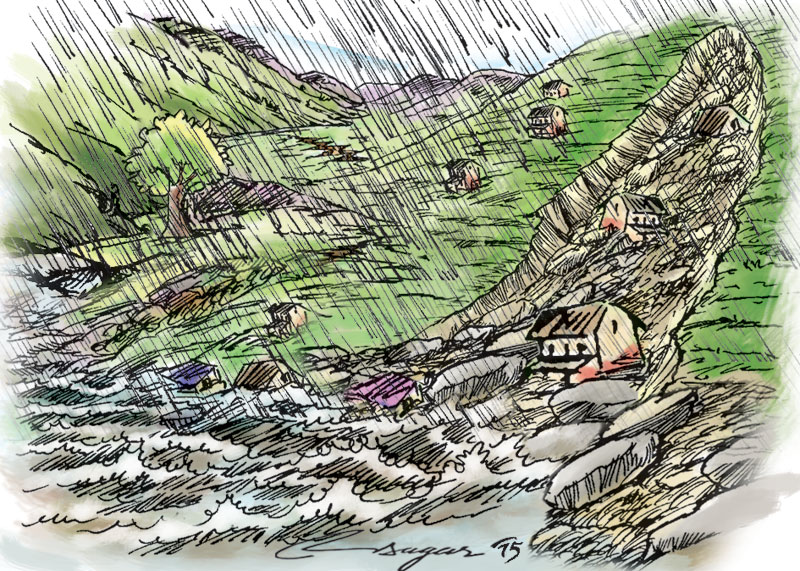Monsoon woes: Quakes portend aggravation
The tale of fissures running from Gorkha to Sindhupalchowk is alarming. Boulders are ready to topple down and mass movement during the monsoonal rainfall. This time we will be facing severe cases of landslides and associated floods, and many of the countrymen will be isolated in these areas
Before the monsoon, like yesteryears, many agencies and government departments are scheduling meets for ad-hoc response to the torrential precipitation led floods. This year, after the devastating quake of 25 April, the scenario is further aggravated in terms of slope failures, landslides and associated floods. Exact monsoonal prediction, dissemination of catchment characteristics, rate of degradation of forest covers and top soil composition, among others, are ubiquitous issues to be resolved in Nepal. Most of the predictions from governmental agencies are inverted and most of the time, there is little dissemination of information to the people under threat of flash floods and landslides.
Normal monsoon in Nepal is expected to occur from June to September, and notably during the monsoon of 2071, the National Emergency Operation Center recorded 70 flood events and many other torrential precipitations guided landslides, flash floods were observed. With due account of such events and flood frequency analysis, the Department of Hydrology and Meteorology (DHM) must predict a model at this moment, otherwise flood fighting is impossible at the eleventh hour.
We are obliged to stay alert with poor predictions on time and again as the DHM prediction seldom correlates the events, hence surely this is the time to boost up the capacity of the DHM. Vicious effects of floods relate to epidemic outbreak, animal attack and loss of biodiversity and human sentiment, among others. Though, the exact rate and status of climate change impacts in Nepal are yet to be predicted, the inter-linkage between hydro-meteorological processes and climate change is seldom discussed.
With increase in surface runoff and inundation in Nepali plain land, the issue is now not only for Nepal, rather this engrosses India and Bangladesh as well. Integrative response from Nepal, India and Bangladesh are strongly lagging behind; and the hiatus in trans-boundary water problems is well reflected in terms of the 2008 Koshi flood. There are many things to be learnt from Koshi and subsequently the South Asian framework against floods and climate change impacts is direly needed at this juncture.
During SAARC or other regional platforms, coping with natural disasters are often dealt as cross-cutting issues, though the entire South Asia is under grave threat of hydro-meteorological disasters. There’s a common marginalization problem in the entire South Asia, as all countries aim for development, rather than a rapid economic development, irrespective of the associated impacts and disastrous outlooks.
The tale of fissures running from Gorkha to Sindhupalchowk is alarming. Boulders are ready to topple down and mass movement during the monsoonal rainfall. This time we will be facing very severe cases of landslides and associated floods, and many of the countrymen will be isolated in these areas. The fissures reflect the vulnerability in terms of landslides, so there’s an urgent need of relocation of the vulnerable settlements.
Budgets allocated for embankments and other preparatory activities in Nepal have not yet reached the field and there are little pre-monsoon preparedness. Hence catastrophic events might overrun the local level initiatives and ad-hoc response would be uneconomic and non-pragmatic as well. Hasty repairing activities at the eleventh hours wouldn’t assure the desired strength and resilience of structural preparedness in terms of flood fighting.
Rather than starting with the monsoon; all repair works are to be done in the pre-monsoon period. Community-based flood fighting mechanisms are feebly practiced. Local good practices, community initiatives, appropriate technologies are resilient practices at local levels. Most of the I/NGOs are fabricating voluminous reports of community initiatives, though the execution level is not as per their documentation. An early warning system is not functional and adequate in Nepal, so the people with low economic status are easily victimized by hydro-meteorological related disasters. In case of floods, the marginalized people, women and children are more vulnerable than any other people. Installation of sirens and mobile voice calls basically in local languages could enhance efficacy of information flow.
The blatant impacts of floods are undoubtedly engulfing resources, human sentiments and national budgets every year. Organizing pre-monsoon seminars with status-quo practices in case of hydro-meteorological modeling and prediction and dormant preparedness initiatives is illogical.
Revitalizing the hydro-meteorological stations, real-time database management, capacity and adequacy of flood forecasting manpower, preparatory works for the possible events, resource allocation and effective mobilization, among others, would surely contribute to better cope with floods and other hydro-meteorological events. As in recent years, through phenomenological studies, it could be said that the rainfall pattern might have shifted somehow. The combined adversities of famine, floods, epidemics, landslides, among others, would surely adversely affect livelihoods in Nepal.
Gautam is a disaster risk reduction expert at Center for Disaster and Climate Change Studies






